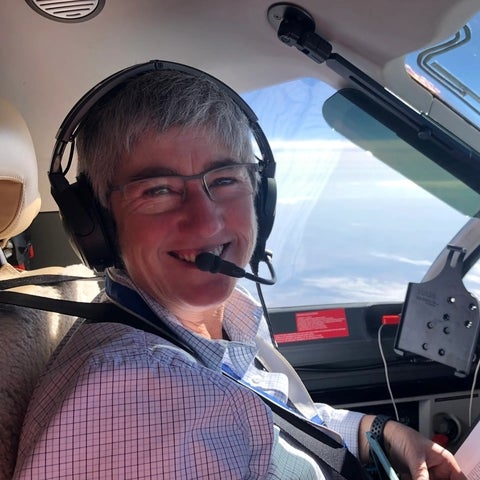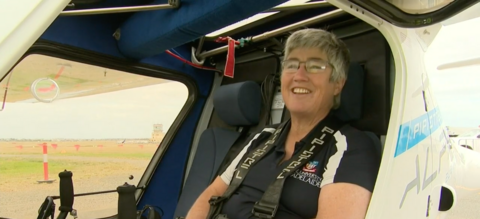Catherine Conway is the CEO and Chief Flying Instructor at AV8 Aero in Australia. When an e-plane (the Pipistrel Alpha Electro) arrived at her home airport (Parafield, South Australia) she was ready, not only to fly, but also to inspect and maintain the Electro. She was also one of the three pilots (along with Barrie Rogers and David Bradshaw) who flew the Electro to set multiple world records during a multi-stage 1350km flight (world multi-stage endurance distance record: 1350 km, longest over-water flight: 30.8km, furthest distance in a 24-hour period: 330km; and fastest speed between waypoints: 177km/h ground speed) around South Australia in June 2021. She continues to provide maintenance and inspection services for the aircraft.
Catherine received an OAM (Medal of the Order of Australia) in 2018 in recognition of her services to gliding (instructor, club president and national team member/captain) and this gliding connection provides the context for her being ready to be an early leader in electric aviation.
In this interview she shares some of her early e-plane experiences.
PP: How did you learn to fly and maintain e-planes? Did you go to Europe for a course, or take a different route?
CC: Actually I did go to Europe, but for completely different reasons. A very good friend of mine is very interested in all sorts of electric vehicles. He's got about four Tesla's and an electric glider (Taurus) built by Pipistrel. I have maintained his gliders for more than 20 years, so he asked me if I'd go to Slovenia, to get my rating to look after the electric Taurus.
In Slovenia, the airplane used on the course was actually a Pipistrel Alpha Electro (with a little reference to the Taurus on the side). We had the opportunity to fly it with the factory test pilots. So, when I came back to Australia and saw the Alpha Electro sitting in the hangar at Parafield and met the owner, he said “I'm not quite sure how I'm going to handle this airplane”. I replied, “Well I'm factory trained in flying and maintenance.”
PP: Wow, he must have been very happy that you walked in, independently trained and able to instruct.
CC: Well, technically I'm not an e-plane instructor. I have been a gliding instructor for over 30 years and we obtained approval to evaluate how we might modify lessons to instruct in the Electro. This involves modifying the standard recreational aircraft lessons for the electric.

PP: Excellent. So, would you share your assessment of the Electro as a trainer?
CC: Certainly, but given that we've really only had the Alpha Electro, it's a bit hard to generalize because some of the challenges may be specific to that aircraft.
For example, we weren't seeing much change to the state of health of the batteries with the circuit training and the ab initio type sequences that we were flying. But when we were pushing it for the record flights, in a straight line at a constant power setting, then we were seeing degradation at the end of those 24 flights of approximately 25 to 30% of battery health. So, the readings from those flights were different to the flights that we were doing at Parafield, which was primarily circuit training.
PP: That sounds like an important finding that needs further research.
(note: POH “State of Health indicates the "age" of the battery. End of life is SOH=0%. This parameter affects the absolute capacity of the battery (energy that can be stored), and the power that the battery can deliver.” It is calculated by the Battery Management System using the voltage readings from the weakest cell. Joseph Oldham, the President/CEO at New Vision Aviation in California, reports that they did not see differences in the SOH between local training and endurance flights when flying their two Pipistrel Alpha Electros. Further comparisons will help determine whether this is a general issue, or just related to that particular set of batteries.)

PP: How about the student perspective, what are the biggest differences that they need to be aware of when training in the Electro instead of a conventional plane?
CC: Well learning on the electric airplane means that they don't learn anything about a piston engine.
Everything else is exactly the same.
The aerodynamics are exactly the same.
The sequences are pretty much the same.
But students may do a double take when they first taxi up to a hold point, pull the power back to idle, and the propeller actually stops.
The same is true for the tower. They had to get used to the fact that when the plane stopped, the propeller stopped. Control would say "0938 your propeller is stopped". I replied "Yes, that's because we're electric."
PP: What about the progression from electric to conventional planes?
CC: Well, students will progress from an electric aircraft at some point because they're just not enough e-planes to continue their career on them alone. They will need to learn about gas powered engines, but really that's no different to what we've been doing for years. We often train people in gliders before they move onto power. I think that gliding gives an awareness and a feel for the air that you don't get from a power plane.
The Alpha Electro is more in that category, perhaps not as much as the pure glider, but in order to fly it efficiently cross country you need to have a glider pilot's awareness of speed to fly, because there is an optimum speed to get the most range out of the battery. You also need to have a feel for the air. It doesn't do you any harm to pick a route with the best lift and we were certainly doing that on the record flight. I flew along the ridge as a source of rising air. Reading clouds and ridges in a very meaningful way is an advantage.
So I think the Electro sits between a normal aircraft and a glider in terms of an introduction into aviation. For glider pilots, it's not much trouble making the transition to an engine and I don't think it will be for electric aviation students either.
PP: Are there any memorable experiences from students that you might like to share?
CC: Well, Pipistrel also make gliders, so the Alpha actually glides quite well when the power is off. So, if you fly the same circuit that you fly in a heavier power plane, you won't get down. One person that I was using for test lessons had just been through the Air Force's training and thought that he was a pretty hot pilot. So, he said he'll come with me and he's got all the military training sequences in his head and he'll let me know what he thinks of the Electro.
Well, three circuits later he still haven't got it on the ground. He was just too high. However, he got his act together on the fourth attempt and did a beautiful landing. That higher glide ratio could be a bit of a problem initially for other pilots. They need a much flatter final.
PP: Very good example, especially with no spoilers or air brakes to help them descend. So, what are the barriers? What is stopping the adoption of these planes for training?
CC: The tyranny of distance. I think people want to jump in an airplane and go somewhere with it. So, I think the time that it will take to get charging stations around the country, and we're not even at a state yet where charging systems are universal. Pipistrel has a proprietary one, it's not the same as Tesla's. Who knows what the standard will be in aviation? No airport is going to be brave enough to lash out the money involved in putting in a charging station if they have to put in three different chargers for the three different types of electric aircraft that might come in.
PP: Exactly, my understanding is that two of the next e-planes are looking at 700 volt systems instead of Pipistrel’s 400 volt system.
CC: So, that's certainly a problem at the moment. They really are best suited to local training, rather than the private owner who wants to go somewhere, because you can install your own charger at the local airport. I think they've got a role to play in flying schools, but also in flying clubs. They're a great cheap way to get people flying.
PP Thank you Catherine!
It is great to learn from your initial e-plane experience and consider the implications for research and pilot training.
On the research side, we should look deeper into battery performance during local training flights versus endurance cross country flights and the impacts on battery state of health.
On the training side, our pilots need to be aware of glide ratios for different planes, or how far a plane will go horizontally for every meter it declines in altitude or height.
Editor's note: Catherine also joined Paul earlier this year on our WISA Talks: Environmental Initiatives in Aviation - watch it now!
